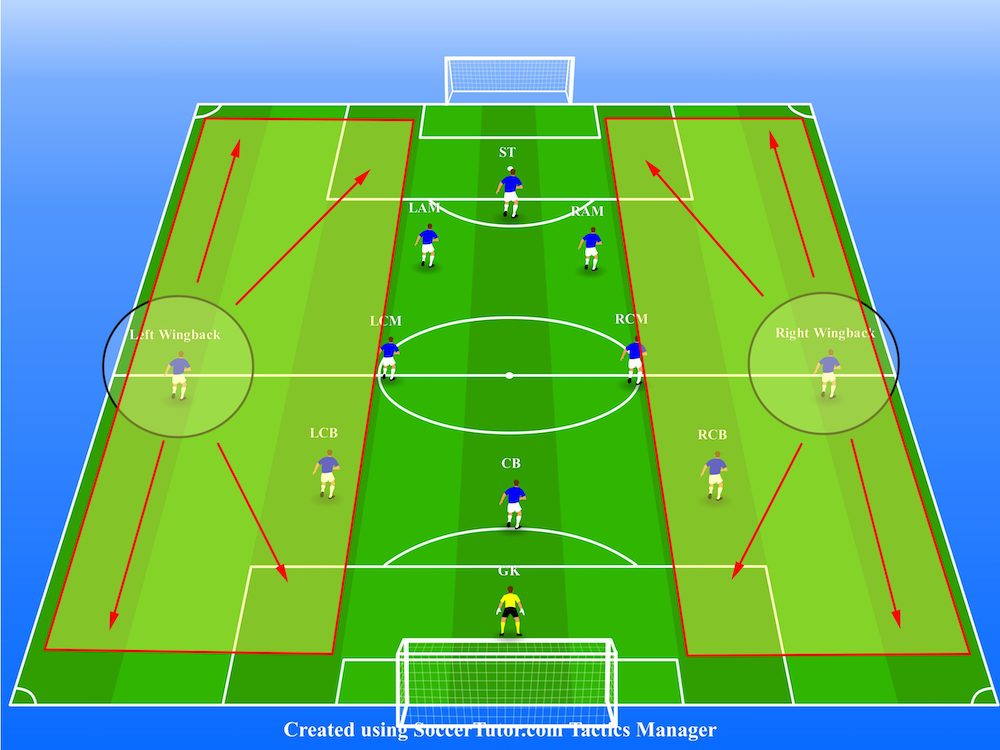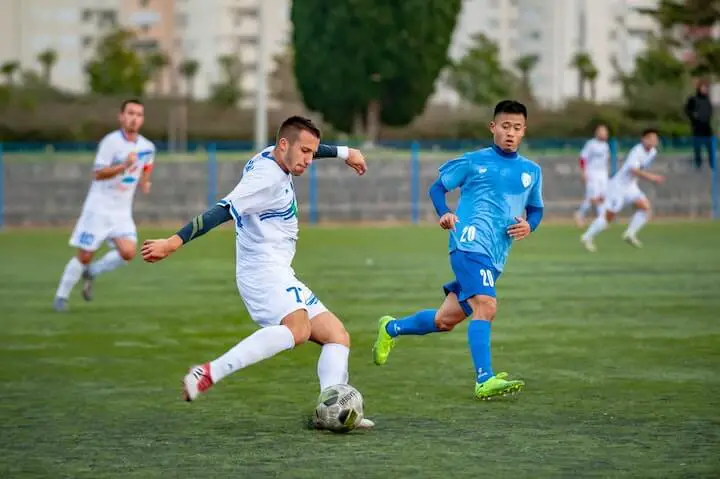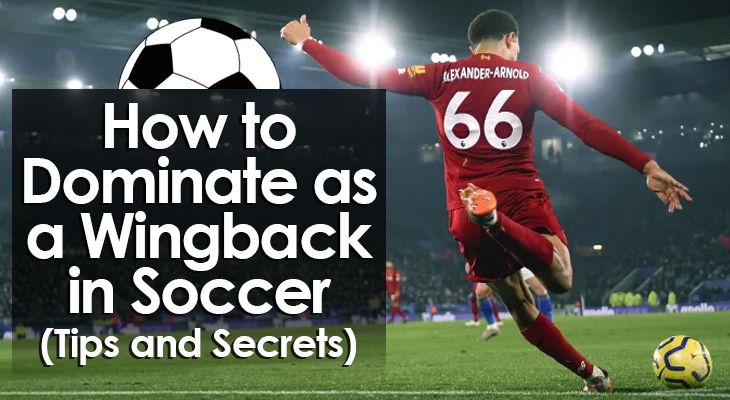What is a Wingback in Soccer? (Full Position Guide)
Wingbacks are somewhat of a variation to fullbacks, usually deployed as part of a five-player backline.
Operating on either side of a center back trio, wingbacks have fewer defensive responsibilities than fullbacks and provide attacking width for their teams.
Utilizing wingbacks can completely transform a team.
Playing between the lines of attack and defense, they have a license to roam and can be difficult to neutralize.
Although playing with wingbacks isn’t the norm, it has been a popular strategy since the 1970s when the Dutch national team used them to great effect.
A wingback in soccer is a dynamic position that can be devastating, especially when creating overloads and numerical advantages in the opponent’s half.
What is the Wingback Position?
A wingback in soccer is essentially a hybrid of a fullback and a winger.
Teams deploy them on the right and left flanks in more advanced positions than fullbacks, but slightly deeper than wingers.
Wingbacks play in formations that use three centerbacks.
Because of the defensive solidity, there is plenty of central cover which allows them to venture forward and occupy attacking positions for large periods.
Although wingbacks must defend wide areas and track back, their true benefits are highlighted during the attacking phases.
Since they’re neither all-out attackers or defenders, wingbacks can position themselves in the half spaces and offer passing options and crossing angles from wide areas.
Unlike fullbacks, wingbacks have more margin for risk-taking and often find themselves getting on the end of deep crosses with late runs into the box.
Unless the opposition also sets up with wingbacks, these types of movements can be extremely difficult to stop.
Position of a Wingback in Soccer
Wingbacks operate along either sideline, covering every blade of grass from end to end.
Their starting position is higher than that of a fullback and there is less of a need for them to drop deep to receive the ball.
Besides playing in a more advanced position than a fullback, wingbacks also tend to stay wider in both attacking and defensive situations.
With extra central defensive support, wingbacks can hug the sidelines to stretch the opposition as wide as possible.
Depending on the chosen formation, wingbacks may be the main offensive threat from the wings.
Their unconventional position on the flank means they can cause a lot of problems for opponents in build-up phases.
Teams expect wingbacks to be in constant motion up and down the sideline so it’s a physically demanding position.
And because of the dual responsibilities, an effective wingback must be highly skilled in attack as well as defense.

What Does a Wingback Do in Soccer?
Wingbacks maraud up the field on attack and shrinks back in defense to shut down runs and aid the backline.
Because of all this back-and-forth, it's safe to say that wingbacks cover a lot of ground, often more than any other player.
Here’s a closer look at a wingback’s main responsibilities.
Wingback's Role In Defense
#1 - Press the Opposition
One of the biggest advantages of playing with wingbacks is they can contribute enormously to a high press.
Whereas a traditional fullback must be careful not to get caught too far forward out of possession, the back three affords wingbacks with the license to commit.
When combined with a tenacious midfield and a hard-working forward line, wingbacks can effectively win back possession in high areas, leading to fantastic goalscoring opportunities.
Aggressive wingbacks can help drive opponents into tight spaces, forcing them to take risks on the ball or turn over possession by clearing their lines.
However, once the press is broken, they must recover into safer defensive positions.
#2 - Fall into a Defensive Unit
If the team turns the ball over quickly or the high press gets broken, wingbacks must retreat into their defensive unit to form a back five.
This creates a stern low block with minimal gaps, making it difficult for the opposition to penetrate.
With five defenders in a row, wingbacks may have the opportunity to step out of the line to engage or press an opponent.
However, this requires clear communication with teammates and it must fall in line with the defensive system.
When the ball is on the opposite side, wingbacks must be aware of any opposition attackers around them and ensure their team covers the back post.
#3 - Mark Opposition Wingers
Many coaches deploy wingbacks to stifle the threat of pacy wingers.
Because of their more advanced position, wingbacks can press wingers higher up the pitch and stop them from receiving the ball in deep areas.
Even if the winger manages to get in behind, there are three central defenders at hand to clean up.
Just like any defensive wide player, wingbacks are faced with 1v1 duels in every game.
Winning these individual battles is key to limiting chance creation for the opponents.
#4 - Provide Defensive Cover
As the “extra” player in many defensive situations, wingbacks must read the game well and offer defensive cover when necessary.
In most cases this involves stepping in for a center back caught out of position or filling their slot if they step out with the ball.
Wingbacks are generally responsible for covering their back post when the ball is on the opposite wing.
Positioning and good reading of the game are essential in making sure no player is left free inside the penalty box.
Wingback's Role In Attack
#5 - Make Runs
When their team has the ball, wingbacks should be on the move, making forward runs and taking up spaces between the midfield and defensive lines.
If they’re paired with a winger, both parties must be on the same page to mount a sustained offense.
Mixing in overlapping and underlapping runs allows wingbacks to receive the ball in dangerous positions.
This type of movement also overwhelms the defense, opening up space for teammates to run into.
#6 - Offer Attacking Width
In the modern game, coaches deploy a back three and wingbacks so they can set up with two strikers.
This means the wingbacks are the primary wide options in attack.
Since defenses must play more narrowly against dual strikers, the majority of available space is on the wings.
Wingbacks should be the consistent outlet in wide areas when building attacks.
They can draw out opposition fullbacks, leaving the strikers 1v1 with the centerbacks.
#7 - Create Chances
Wingbacks are key creators for their sides, tasked with making goalscoring opportunities.
Good strikers of the ball can create chances from anywhere with inswinging crosses, over-the-top chips, or through passes to their strikers.
Pacy wingbacks will often try to beat their defender 1v1 or run to the by-line to get a cross in.
Alternatively, playmaking wingbacks may take a step infield to help create overloads in central areas.
#8 - Score Goals
Although they’re unlikely to be top scorers on their teams, wingbacks should contribute a few goals for their team each season.
Occupying advanced positions for large periods of the game, they should find themselves within shooting range frequently.
One of the best ways for fullbacks to get on the scoresheet is to make late runs into the penalty box.
With good timing, wingbacks often find themselves in acres of space at the back post.

Best Wingbacks of All Time
Most wingbacks don’t spend their entire careers in the role; rather, they adapt to the tactics outlined by their coach.
So, my all-time list of wingbacks contains some players who were successful as wingbacks and other positions (fullbacks and wingers).
- Roberto Carlos
- Paolo Maldini
- Javier Zanetti
- Giacinto Faccheti
- Philipp Lahm
- Djalma Santos
- Dani Alves
- Carlos Alberto
- Lilian Thuram
- Achraf Hakimi
5 Bonus Tips for Wingbacks
Most wingbacks start their careers playing in a different position, typically as a fullback or a winger.
If you’re transitioning into a wingback role, here are some top tips to aid your progress.
a. Work on Playmaking Skills
Fullbacks find themselves in great positions all the time.
Develop your playmaking skills to ensure you can be effective in these scenarios.
Practice striking the ball in different ways and from a variety of positions to make yourself more of an offensive threat.
Crossing and long-range passing are two of the best playmaking attributes of a good wingback.
Tip #2: Develop Elite Stamina
Great stamina is mandatory for a wingback in soccer.
You can develop elite-level fitness by doing some extra running and conditioning outside of training.
However, most people underestimate how much more effort they can give in practice to increase their stamina.
So, get into the habit of being the hardest worker.
Tip #3: Become a Student of the Game
It may take a while to adapt to the wingback position.
One of the fastest routes to success is to study the greats and pay attention to what they do well.
Key areas of focus are general positioning, actions during transitions, and the wingbacks’ involvement in the offense.
Tip #4: Make a Habit of Talking on the Field
Due to the distance a wingback in soccer covers during a game, it’s easy to get caught out of position.
Therefore, it’s important to communicate effectively on the field to stay alert and aware of what’s happening.
This is a habit that starts on the training ground.
Forge strong relationships with other defenders, midfielders, and wingers, and be sure to instruct and guide each other through each game.
Tip #5: Practice Finishing
You may be surprised at the number of chances that come your way as a wingback.
Be ready to take these chances by brushing up on your finishing.
In particular, make sure to practice finishing from crosses, mixing in headers, volleys, and ground strikes.
Conclusion
Since a wingback in soccer is essentially a mix of two positions, it’s a difficult role to master.
Wingbacks are only deployed in somewhat unconventional formations in the modern game.
When utilized effectively, however, wingbacks can be devastating.
With this guide, you can implement the changes you need to dominate as a wingback for your team.

